Jerry Daly, from our Global Health Institute at Loma Linda University Health, and I recently returned from a quick trip to Rwanda to look at starting a new medical school there. We were hosted by Hesron Byilingiro, president of the Rwanda Union of Seventh-day 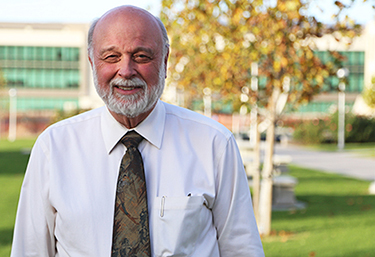 Adventists, and Ndahayo Claver, vice rector (VP) of academics at the Adventist university there. It will be the sixth Adventist medical school that LLU has assisted over the years.
Adventists, and Ndahayo Claver, vice rector (VP) of academics at the Adventist university there. It will be the sixth Adventist medical school that LLU has assisted over the years.
First, Universidad de Montemorelos in northern Mexico, an hour and a half drive south of Monterrey, started a medical school some 40 years ago. Then came Universidad Adventista del Plata in the farmland of Argentina, which began its school of medicine around 20 years ago. Both of these schools are now mature and educating physicians. Then for many years, other countries were discouraged from starting new medical schools due to the costs and difficulty in finding quality faculty at both the basic science and clinical levels.
But recently the hold was lifted, and a number of countries are responding to what they perceive as constituent pressure and market opportunities. Babcock University, an hour out of Lagos, Nigeria, started its medical school first, about three years ago. Then Universidad Peruana Union in Nana, outside of Lima, Peru, began one two years ago. Finally, the Adventist University of the Philippines, in the hills outside of Manila, opened its school of medicine this past August.
Loma Linda University Health has assisted with each one of these, on accreditation visits, consultations and curricula review, and with teaching faculty assistance. They all have students on board and are working to produce quality professionals. Several other countries are also planning new medical schools.
There are two foundations from which medical schools usually start. Some come from existing universities that want to expand their academic offerings. Usually they have other health science programs already in place, such as nursing. The other option is a hospital that wants to start a school of medicine. These institutions understand the medical model and have the clinical faculty already on board, but they need to develop the academic structure.
Places without a hospital must search out appropriate clinical sites and recruit a faculty committed to education. They occasionally use a government hospital, where quality is often stretched by large patient volume. Motivating and reimbursing busy physicians to engage in time-consuming mentoring of students can also be difficult. Both Babcock University and Adventist University of the Philippines are faced with this challenge. Universidad Peruana Union is using the expanded Good Hope Clinic, a flourishing hospital in Miraflores, Lima, for most of its training.
Adventist University of Central Africa
And now the Adventist University of Central Africa (AUCA) in Rwanda has been approved to plan for a new medical school. This institution has quite a history, beginning with the recognition that the Adventist Church needed a French-speaking university to serve the many French-language countries throughout Africa. It was organized as Universite Adventiste d’Afrique Centrale in 1978, in Rwanda, at a place called Mudende. The university officially opened its doors in October 1984 and was chartered by the Republic of Rwanda in 1988.
It was a beautiful campus in the rolling countryside, in a country where an estimated 12 percent of the total population identify themselves as members of the Adventist Church. But then came 1994, with the most horrific genocide of the last quarter century. AUCA (Mudende) 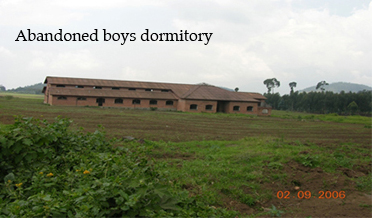 became the site of a horrific massacre of both students and faculty. The green fields of Rwanda ran red with blood. Nearly 1 million Rwandese were murdered — almost 10 percent of the entire population of the country — over the course of three months.
became the site of a horrific massacre of both students and faculty. The green fields of Rwanda ran red with blood. Nearly 1 million Rwandese were murdered — almost 10 percent of the entire population of the country — over the course of three months.
With the university’s faculty and leadership gone, the church in Rwanda had no heart to start again in Mudende. Healing had to take place before a decision was made to reestablish AUCA again, this time in the capital of Kigali. By then the country had undergone the difficult task of reconciliation and had started on the long road to development once again, including a major transition from French to English as their language of choice. People were encouraged to think of themselves as Rwandese, not Hutus or Tutsis, as the tribal barriers began to fade.
Rebuilding
A small parcel of land was initially obtained in Kigali, and AUCA reopened in old rundown buildings in 1996. Students started coming, confidence was regained, and the dream of a new campus started building. With this momentum, the government made available a large piece 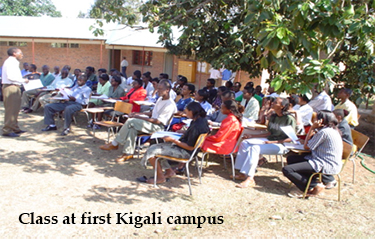 of land on the hills overlooking the city. The country itself was riding an economic wave of growth brought by stable national politics and solid fiscal management, resulting in considerable donor assistance and a renewed sense of optimism.
of land on the hills overlooking the city. The country itself was riding an economic wave of growth brought by stable national politics and solid fiscal management, resulting in considerable donor assistance and a renewed sense of optimism.
Within this climate, the church started an ambitious development program for AUCA on the new land. A key call was made for Angie and Dominic Pagarigan from the Philippines to join AUCA — Angie to serve as vice rector (VP) of finance, and Dominic to oversee the design and construction of new buildings. A major academic and administration block was completed in 2007, followed by a large auditorium/church, seating 1,800. This became the Masoro campus of AUCA.
This kind of progress does not go unnoticed, and the Rwandan government encouraged AUCA to develop additional programs. Adventist Health International had become involved with Mugonero Hospital by then, located four hours west of Kigali overlooking Lake Kivu. Plans to reopen the school of nursing at Mugonero were considered, with debate about what level of training would be best and whether it should remain a hospital-based program or instead become part of the university. Either way, major remodeling of the classrooms, dormitories and hospital itself were needed at Mugonero, and these are underway, mainly from church finances. A bachelor’s-level nursing program has now begun at Mugonero, now called the Ngoma campus of AUCA.
Serving sub-Saharan Africa
There are three divisions of the Adventist Church in sub-Saharan Africa, named geographically — West-Central Africa, with its new medical school at Babcock University in Nigeria; Southern Africa-Indian Ocean; and East-Central Africa. They have a collective church membership of 6.7 million in a population of around 900 million — nearly 1 percent.
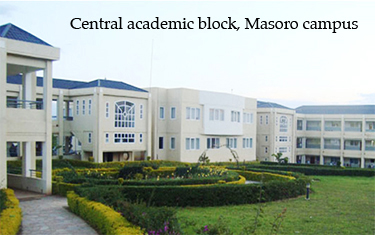
As plans for a new medical school within the East-Central division at the University of Eastern Africa Baraton began to fade due to political strife in Kenya, the dream of AUCA starting a medical school on its Masoro campus was born. This was greatly encouraged by the government, as they recognized the quality of Adventist education and the international resources available to AUCA. Loma Linda was already assisting Malamulo Hospital, in Malawi, part of the Southern Africa-Indian Ocean Division (SID), to start residency programs for specialty training of physicians. So there was a certain logic to have a medical school in the East-Central Africa division and postgraduate training next door in SID. We believe this sharing of programs and faculty can work well for now, and we look forward to working with both these divisions.
Promising future
Rwanda has been called the Switzerland of Africa because of its steep hills and valleys, literally terraced to the top with eucalyptus, bananas, maize and beans, along with occasional other crops. For a farmer like me, there is nothing more beautiful than an entire country covered with verdant green crops. On this trip, we drove west to Mugonero, then on farther north to Ruhengeri, close to both the Uganda and Congo borders, nestled among dormant volcanic mountains. The government has offered AUCA clinical training sites at the busy provincial hospital there, which has 15 deliveries a day in the maternity unit, but it is in the public sector, with little opportunity to create our own culture.
Kigali, the capital of Rwanda, is being called the Singapore of Africa due to its clean streets, lack of beggars, manicured landscaping, new buildings and generally bustling economy. We met with both the minister of health, a young, engaging neonatologist trained in Europe, and the minister of education, who has a PhD in economics. Hand-picked by Rwandan President Paul Kagame to help pursue his dreams of rapid development, they epitomize the welcome spirit of collaboration that one finds everywhere in Rwanda now.
So the political doors are wide open, with beautiful space available on the large new Masoro campus for academic buildings, dormitories, a hospital and clinics. All we need is funding and the right people.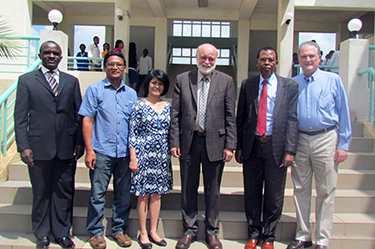 AUCA is currently searching for a new rector (president) and also a founding dean for the school of nursing. Kenny Vicente from Universidad Adventista del Plata has agreed to come as the founding dean for medicine. We will talk more at Loma Linda about how to engage, but I feel this is a place that both needs and deserves some major assistance as they build toward the lofty goal of quality medical education to serve Africa.
AUCA is currently searching for a new rector (president) and also a founding dean for the school of nursing. Kenny Vicente from Universidad Adventista del Plata has agreed to come as the founding dean for medicine. We will talk more at Loma Linda about how to engage, but I feel this is a place that both needs and deserves some major assistance as they build toward the lofty goal of quality medical education to serve Africa.
Several key decisions have already been made — the school needs to be seen as a regional, not national, entity, serving all of east, central and southern Africa; we need our own teaching hospital to create the professionalism, compassion and skills that we should be known for; we should emphasize the recruitment of young women into medicine; and we should not be hesitant about making this an Adventist faith-based institution, with all that this means. Rwanda is 95 percent Christian, so this last point will be understood and widely accepted.
I am always humbled on these trips by how widely Loma Linda University Health is known and respected, and it is hard to keep from creating expectations that may be difficult to fulfill. We are blessed with our global network of partner institutions, and it is a privilege to work with them toward this type of goal. Pray for this endeavor that once again we may continue the teaching and healing ministry of Jesus Christ.
Sincerely yours,
Richard Hart, MD, DrPH
President
Loma Linda University Health